Oxygen
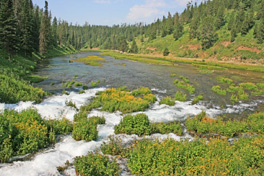
Oxygen is essential to all aquatic animal life. Because the distribution of oxygen throughout a body of water without it respiration is impossible. Can vary widely, it is important to find the specific areas which hold optimal amounts to support fish life. Oxygen concentration is a prime factor in locating where specific fish species are found.
It’s self evident that air accommodates an abundance of oxygen; however, water holds a much smaller amount. For example, one liter of air contains about 210 cubic centimeters of oxygen; while, one liter of water has only about 9 cubic centimeters. In air the lack of oxygen is rarely a problem, but in water its effect is more apparent. Water harbors a tenuous margin of safer because its oxygen content is small, and varies widely. Insufficient oxygen supplies will result in animal death.
Two physical factors affecting waters oxygen content are altitude (atmospheric pressure) and temperature. Oxygen solubility in water increases with decreases in both temperature and altitude. Conversely, oxygen solubility decreases with rises in temperature and altitude.
Atmospheric pressure is inversely proportional to altitude. That is, a rise in altitude lowers the atmospheric pressure, and a decrease in altitude raises the atmospheric pressure. On the other hand, atmospheric pressure is directly proportioned to oxygen water solubility. That is, a rise in atmospheric pressure increases to waters oxygen content; while, a decrease in atmospheric pressure lowers the waters oxygen content.
Oxygen diffusion occurs at the water’s surface, and its mixing throughout happens during a lake’s spring and fall turnover times. Oxygen diffusion process is very slow. Both wind and wave action mixes oxygen at the surface, while, plant photosynthesis generates oxygen. Since plants are present. In deep water, where light cannot penetrate, oxygen cannot be produced by plants. Hence, a lakes hypolimnion only receives its limited oxygen by spring and fall mixing turnovers. This is why a lakes greatest depths can become so oxygen poor. The stratification of water layers seals the hypolimnion from the surface air supply; furthermore, this seal is only interrupted at spring and fall turnover.
An increase in water temperature lowers the amount of oxygen it can contain. During hot conditions a lakes shallows may become too warm to hold sufficient oxygen, and the animal life forms must migrate to cooler oxygen richer regions. Inlet streams and underwater springs can supply the needed oxygenated
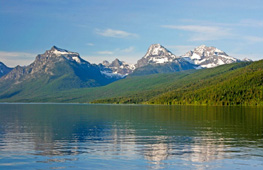
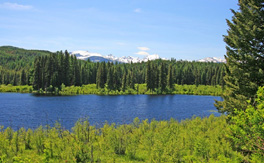
water. The deeper shaded areas just above the thermocline can be cool enough to hold sufficient oxygen. Fish concentrate in these limited areas when such conditions prevail.
Since a lake depends upon wave action, photosynthesis, and currents to mix and produce its oxygen, areas of adequate and inadequate oxygenated water exists simultaneously. This result’s in areas where fish can and cannot live. It is a precarious balancing act amid oxygen contents, temperature, light intensity, protective cover, and available food supply that dictates just where fish can be found.
Altitudes influence on an alpine lake can be dramatic. For example, in my youth I spent considerable time fishing alpine lakes above ten thousand foot altitude. During the dog days of summer my success dramatically fell. I was puzzled because these alpine lakes contained colder water than their valley counter parts. The alpine lakes depths were void of fish, and my success was restricted limited to the lakes shallows. Earlier in the season the angling was good in the alpine lakes depths. Now in midsummer the fishing was poor. The valley lakes fished best in their depths; while, the alpine lakes fished best in its shallows. I neglected to take into account the difference between the lakes altitude and atmospheric pressure. The high altitude lakes oxygen was less because there was less oxygen available when the spring and fall turnovers occurred. This limited oxygen supply was quickly depleted in the alpine lake’s depths. Simply, fish couldn’t live in the alpine’s lakes depths. The lower elevation lake, take in higher oxygen content during the spring and fall turnover times. This confined the alpine lake’s fish to the shallows; while, the valley lakes fish were in the lakes depths. I once thought that all big fish lived in the depths and only smalls ones were in the shallows. This notion is untrue.
Rivers current mixes oxygen much better than a lakes waves and limited currents. Also, this thoroughly evokes little variation in both, oxygen and temperature times, the white water river sections mixes higher oxygen content. In times of hot spells fish may migrate to the rapids for survival.
Look for them in the pocket areas downstream from rapids. Also, areas close to adjacent inlet streams and underwater springs can harbor more favorable conditions. For example, in warm thermal rivers such as Yellowstone Park’s Firehole River, fish migrate to the mouths of cooler tributary streams during warm seasons.
In conclusion, the oxygen content of water is a prime factor in determining fish’s locations. An adequate oxygen supply is essential to sustain fish life.
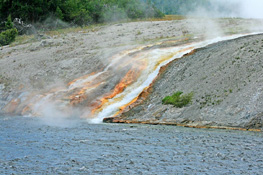
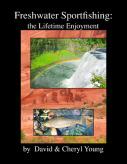
© 2026 The Gale Group, Inc. All rights reserved.
© 2026 Perigee Learning LLC. All rights reserved.
LoveTheOutdoors.com is owned and operated by Advameg, Inc. © 2026 Advameg, Inc.
Camping Adventures • Dutch Oven Cooking • Sports Knots
Fly Tying • Freshwater Fishing • Fly Fishing

